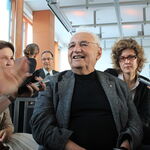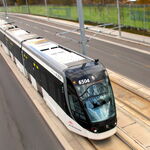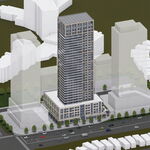Comments on today's vote:
LEVY: Councillors backpedal on Yonge St. bike lanes — for now
Jess Spieker, of Friends and Families for Safe Streets, informed the members of public works committee Tuesday that “road safety” is their job and continuing to allow people to cross a six-lane highway (her depiction Yonge St., north of Hwy 401) is “dangerous and unsafe.”
The personal trainer — who according to her own bio serves clients mostly in the downtown core — warned councillors, in a voice dripping with self-righteousness, that turning down bike lanes on Yonge St. — all to “save 1,600 York Region drivers” — is “perverse.”
That theme — that 905ers have no right to use Yonge St. to commute from York Region into the city — was reiterated a number of times by the sanctimonious and assorted friends of John Filion, the well-past-his-best-before date councillor behind the $51-million REimagining Yonge St. scheme. Besides prettying up Yonge St.,
Councillor John Filion (Toronto Sun files)
the plan calls for taking out two lanes of traffic in one of the most congested corridors of Toronto (Sheppard up to Finch Aves.) for dedicated cycle tracks.
Two members of the Filion fan club — Bill Keenan and Kaye Rickatson — snorted derisively at commuters who dare to use Yonge St. and at Councillor Stephen Holyday for making it clear he didn’t support putting cycling tracks on Yonge St.
“Our neighbourhood shouldn’t be held hostage by commuters from the 401 … or by businesses who think the sky would fall,” sniffed Keenan.
Rickatson told Holyday she had a “nice car” but didn’t intend to drive it.
Even Filion, the councillor who was also behind the city’s failed A la Carte plan, served up this priceless little insult: “We have to do something to discourage the 905ers from going through the centre of the city.”
But after two hours of this kind of out-of-touch, self-serving nonsense from the cycling lobby, a bare quorum of councillors — led by Holyday and David Shiner — opted 3-1 to approve the alternate plan which proposes sprucing up Yonge St. but without removing any lanes of traffic. The bike lanes would be installed on neighbouring Beecroft Rd. at an extra cost of $9 million (instead of the $22-million originally proposed.)
Holyday said he’s very concerned about introducing more congestion along the proposed section of Yonge St.
“Everyone seems to dump on the 905ers and people in the north end of the city,” he said. “Maybe they’re coming into the city to shop or access their job … It’s extremely important to their quality of life to be able to move around.”
He’s 100% right. But one should never underestimate the ability of the cyclepaths and the ideologically driven damn-the-torpedoes councillors at City Hall — Joe Cressy being at the top of the list — to intimidate council into making dumb decisions.
This still must go to council at the end of next month and that gives the tag team of Cressy and Filion time to encourage councillors to ruin Yonge St.
Cressy — seemingly miffed that he and his cyclepaths lost the vote Tuesday when they’ve been so successful at ramming bike lanes down everyone’s throats up to now — tried to suggest that those who oppose the bike lanes on Yonge St. are still locked in the 1950s instead of wanting to invest in a 21st-century city.
And then he outdid himself with vintage Cressy spin. He suggested that the bike lane vision will create a “vibrant Main St. for business and economic development” where people want to come — just like what he has in the downtown neighbourhoods where he resides.
I wanted to stand up and shout: “Just like King St. where you’ve created a Ghost Town, Mr. Cressy? Or how about Bloor St. where small entrepreneurs are hanging on by their fingernails and are afraid to say how poorly they’re doing for fear of being intimidated by the bike lobby?”
But I bit my tongue and saved my response for this column.
CP24-
The city’s public works and infrastructure committee has opted to ignore a staff-endorsed plan for the revamping of a portion of Yonge Street in favour of a more modest proposal that doesn’t call for the removal of two lanes of traffic in a busy North York strip.
The initial proposal, endorsed by staff and backed by the local councillor, called for Yonge Street to be reduced from six to four lanes between Sheppard and Finch avenues in order to accommodate a bike lane, wider sidewalks and a landscaped median.
In arguing for the plan, staff had said that it “provided the best support for vibrancy” and would help create a Main Street culture along that stretch of Yonge Street.
The plan, however, was opposed by Mayor John Tory and some of his allies, who were concerned about the potential impact on traffic.
They pushed for a scaled-down version of the plan, wherein a bike lane would be put in along a parallel corridor on Beecroft Road, allowing the number of lanes of traffic along Yonge Street to stay the same. Staff had reported that the plan was viable after being asked to study it but did not favour it over the more dramatic proposal that they previously endorsed.
Nonetheless, members of the public works committee voted 4-1 in favour of the scaled-down plan on Tuesday.
The vote came one week after nine community organizations sent Tory an open letter calling on him to “demonstrate leadership” and support the initial proposal, one that they called the “the only way forward for safe streets”
“I want increased cycling infrastructure across the city, make no mistake about that. I just want it done in a sensible and balanced way that takes into account that there are other interests, including the public realm, including car drivers and including transit vehicles that have to move along Yonge Street,” Tory told reporters ahead of the vote on Tuesday morning. “I want to make sure that whatever we improve in the end – and it will come to council – is something that is balanced and takes everyone’s interest into account.”
Staff said impact on commute times would have been minimal
Traffic modelling data that was included in the initial staff report had suggested that commute times along Yonge Street would only be slowed by one or two minutes on average as a result of the removal of the two lanes of traffic.
Opponents of the plan, meanwhile, contended that any increase in commute times along an already traffic-clogged artery would be unacceptable.
In a message posted to Twitter following the vote on Tuesday, former Chief Planner Jennifer called the decision “small-town thinking” and said that the initial plan was “key to attracting growth” for the area and turning it into a “walkable destination.”
“Pathetic! We should be sick and tired of this small-town thinking. This is an urban centre above a subway line. Councillors redrawing years of staff analysis on the back of a napkin. We are better than this, Toronto,” she wrote, using the hashtag #LeadershipNeeded.
The proposal approved by the committee on Tuesday was initially supposed to add $20 million to the $51 million cost of the staff-endorsed plan but it appears as though some savings will be realized by forgoing the acquisition of some property that was required for the installation of the bike lane.
The motion approved by the committee states that shared-lane pavement markings will instead be implemented along a portion of the bike lane until a section of Greenview Avenue is reconstructed and widened.
The proposal still needs to be approved by city council as a whole.








